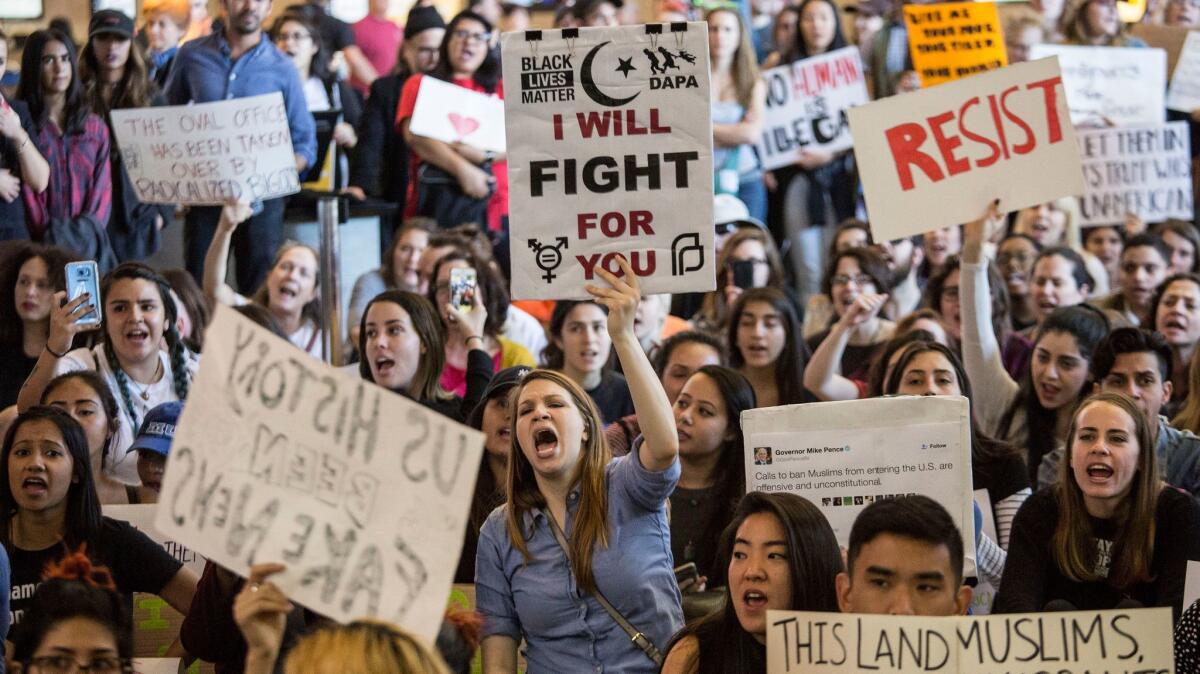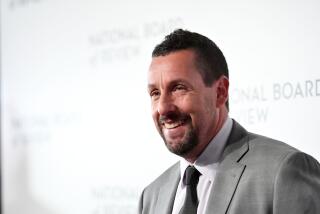Strong women in front of the camera inspire the filmmaker behind it

Tani Ikeda and a film crew capture the Muslim ban protests through the eyes of Traci Ishigo and Sahar Pirzada two young women standing together in solidarity against Islamophbia.
Tani Ikeda is a Los Angeles-based filmmaker and co-founder of imMEDIAte Justice, a nonprofit that connects with young women from underserved communities and allows them to tell stories through film. On Jan. 28, after President Trump made his first executive order restricting travel from seven majority-Muslim countries, Ikeda and a film crew captured the LAX protests through the eyes of Japanese American Traci Ishigo and Muslim American Sahar Pirzada, two young women standing together in solidarity against Islamophobia.
Q. How did you get into filmmaking?
I was so inspired by the possibility of becoming a filmmaker, which at the time as a teenager was a little bit of a trap. I applied to USC film school and was accepted. And after school, I was a camera assistant on music video sets and worked my way up to directing music videos and commercial projects.
This past year and a half, I pivoted into documentaries because I still felt very called to tell the under-told stories from my community and marginalized communities.
Q. I see a lot of your subjects or topics tend to be about strong women. Is there a theme to the stories you tell?
My experience has been that the people on the frontlines right now doing the work are all women of color. Not to say that there aren’t men doing good work, but I think if you look at the movement moment right now, particularly Black Lives Matter, the leadership is primarily queer women of color, black women and trans folks. In Standing Rock and undocumented communities across the border, we see real leadership coming from women.
Q. So how did you find those two characters from this film, and how did you decide to follow them?
I’d known about the work of Vigilant Love. It’s this coalition of organizers both from the Japanese American community and Muslim American community who have been building solidarity since 9/11. What was really amazing to me about the friendship between Traci and Sahar is an action like the LAX protests happened instantaneously, and that’s what people saw. But behind the scenes, the people who were building the infrastructure for a direct action had been building together for years. And they had a trust and rapport and a love for one another that was so deep, that you could turn on a dime and create mass action
A friend introduced me to Traci the day before the LAX protests, and then I met Sahar. So I was really lucky to find them. I was there in the morning, when they were nervous and unsure if anyone would show up, and it was amazing to really see how the day unfolded. I think for me, documenting that moment when there were thousands of people at LAX, I became really aware of the fact that if people had shown up for Japanese Americans in the same way, our community would not have been incarcerated. At the time, there was this media turnout of fear, and our neighbors were too afraid of us to stand up for us. I think there’s a lot of parallels now between the Johnson-Reed Act and Trump’s executive order today.

Q. How do you find a good story?
A lot of times it’s finding somebody who has the generosity of spirit to really allow you into their lives. The other thing that I’m finding is, oftentimes people are drawn to really aggressive storylines, really masculine, action-packed stories. I’ve always gravitated toward the stories of women of color, but I’ve also struggled with knowing how to tell those stories because I’ve grown up being told that our stories don’t matter. So just by sitting and bearing witness to the stories of women, started to put me into a rhythm where I’m finding value in stories that maybe a number of people have overlooked, and then they’re able to see these women in the same ways that I see them, which is full of love.
So many documentaries have this sterile, colonial gaze at their subjects, and it’s almost like looking through the view of an anthropologist. I think documentaries have the ability to gaze at their subjects with love the way you would look at somebody who’s a lover. And so for me, it’s really about honoring the real relationships that exist between me and people in my community, and that feels different to audiences because we’re not photographed, filmed in that same loving gaze.
Q. You came from music videos to working on documentary. What do you like about the documentary work that you do now, and do you feel your past work has helped you develop your aesthetics now?
I’m really inspired by films like “The Act of Killing” that understand that audiences are sophisticated enough to know that introducing a camera actually changes the story in the equation. So I think it’s really more self-reflective in documentary. Having a background in music videos and really thinking about curating visuals is something that I also bring to the table for a documentary because your subjects are actually more like your collaborators because they’re agreeing to tell a story with you. So the way you’re framing things, the way you’re setting up your shots, I think there’s a certain lyrical quality that is maybe a bridge from music videos.
I shot this documentary in Beijing, China, about a farmer and his wife during the harvest. I tried to film it like I would a feature narrative in how I set up the shots. So the aesthetics are really important to me because I think our stories deserve to be elevated.
Q. I think there’s something really special about the idea of women of color leading these protests and featuring young women filmmakers of color, like yourself. What does that mean to you?
It’s sort of like this self-reflective process. When you see images of what you can become, it’s this pathway into the future of what’s possible. And if you’re documenting it, it’s almost like you’re showing an audience a way forward at the same time that you’re uncovering the brilliance of what’s already happening, what our communities are already doing and validating that that’s what’s happening.
Q. Do you have any advice for young filmmakers?
Really lean into your own perspective and trust that it has a lot of value. I spent the first half of my filmmaking career trying to prove that I can be commercially viable and create work that was “accessible,” only to discover that the best way forward was for me to be myself.
People at times thought I was too rough around the edges and too politically charged. And now in this moment, I’m so happy to be telling these stories in collaboration with people. This moment is really asking for more of those stories.
If people can lean into the things that they love, that they believe in, that is the best way forward.
I made a lot of experimental films as a teenager in my early 20s and then tried to talk myself out of it because I convinced myself that nobody wanted to see those films. And now, with some of my friends who are younger, I tell them they should absolutely be making weird experimental films, and those films will absolutely stand out because they won’t look like anything else.
I think it’s also important to allow yourself in this political moment to stay angry and let yourself be affected, let yourself be heartbroken by everything that’s going on. Allow yourself to be shocked because it’s so easy to normalize the violence that’s occurring. And as storytellers, it is our job to continue to feel all of it and to turn those into stories that allow other people to feel what it is to be alive in this moment.
More to Read
Only good movies
Get the Indie Focus newsletter, Mark Olsen's weekly guide to the world of cinema.
You may occasionally receive promotional content from the Los Angeles Times.






